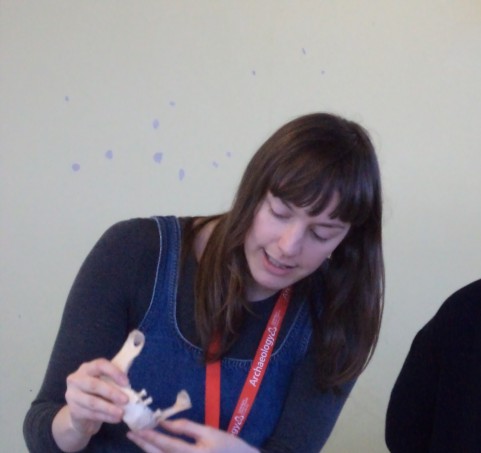Before I get down to the news this week, and even though I don’t yet have the final figures, I thought I would update you on what I think the Medieval Canterbury Weekend 2018 has raised for the Ian Coulson Memorial Postgraduate Award fund. As I reported in February, we at the Centre had intended to use the Michael Wood lecture in October 2018 to raise £2,000 for Canterbury Archaeological Trust after the disastrous break-ins to the Trust’s artefact stores. This lecture will now come under CCCU’s Open Lecture series, so instead we have decided to give £2,000 from the proceeds of the Weekend to the Trust, with the remainder of the surplus after costs going to the Ian Coulson Award fund. In round figures, I think this means about £8,000 to the Award fund, which I think is excellent and is due to you, our audiences, being prepared to come to Canterbury to listen to history talks and to be guided around many of the city’s wonderful medieval buildings. Furthermore, I said I would let you know when Matthew Crockatt had set up the ‘legacy’ site for the History Weekends, including the twitter feeds, well he has done a great job and everything is available: http://www.canterbury.ac.uk/arts-and-humanities/research-kent-history-and-archaeology/history-weekends/history-weekends.aspx so please do check this out.
Now to the final event of the Medieval Canterbury Weekend 2018, when Dr Diane Heath and I teamed up with Dr Ellie Williams, the osteoarchaeologist at Canterbury Christ Church, for two ‘Young Medievalists’ workshops last Saturday. This was a first for CCCU and the Centre, but also for the three Young Archaeologists Clubs involved because, as Peter Walker the leader of the Canterbury YACs said, Kent YACs have never done a joint event like this before.
In order to give everyone as much of a chance to take part as possible, we had arranged one workshop on Saturday morning and then a repeat in the afternoon, and joining us in the morning was Lyndsay Ridley, from The Canterbury Tales, and in the afternoon Josh Tyerman, one of Ellie’s third year students. As well as the leaders of the various YAC groups, there were several parents, and for many of them the chance to handle bones was as new for them as it was for their children.
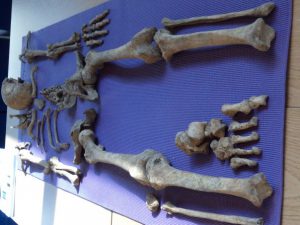
Skeleton of a Roman man from Canterbury (from CAT excavation)
Ellie has organised such workshops before when she was at the University of Southampton, consequently she had set out a fantastic display on three table of a Roman human skeleton, another from the Anglo-Saxon period, and a third with a skeleton of a sheep, a box containing the bones of a dog for them to assemble and a collection of other animal bones, some fossilised and several other objects. She also had a small ‘station’ with a skull and jaw bone for the youngsters to think about aging a person using their teeth, and, finally, Diane had brought in a couple of CAT Kit boxes for the YACs to work on objects – material culture. To this ‘station’ Ellie added her mystery object, for all she had told them was that it was made from horse bone and it was one of a pair.
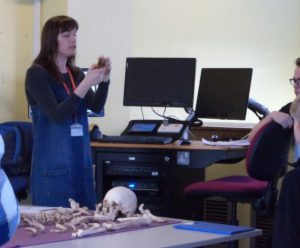
Ellie discusses the Anglo-Saxon skeleton.
With this wonderful array before them and after a quick lesson on does and don’t because these were people from the past and their bones should be treated with respect, the morning group from Canterbury YAC got to work using Ellie’s guideline sheets on what to look for and how to record their findings. In addition to the idea of aging using the state of the molar teeth, which certainly got the YACs talking, the youngsters discovered how to work out whether they were looking at the skeleton of a man or a woman by observing the shape of the skull and the pelvic bones, as well as their size. To make it more interesting and truer to life, the pelvic bones of the Anglo-Saxon skeleton were not obviously ‘male’, whereas the skull was easier to identify as male, and this provided the useful lesson that people vary and do not always show classic features as seen in text books.
The Roman skeleton was also that of a man, and in this case the pelvic bones were closer to the classic male appearance. However, this was only the start and Ellie had selected this individual because he had obviously suffered physical problems during his adult life, so much so that there were tell-tale signs on his bones. Perhaps not surprisingly, both individuals had suffered from osteoarthritis, the evidence coming from the shape of some of their vertebra, but the Roman man’s discomfort had been even greater due to two further serious injuries. Even though not all of the skeleton has survived, including a large missing part from his skull, four of his ribs from his right side are still present. This meant the youngsters could see what shape the ribs should be and could then compare the two ‘good’ ribs with those that had sustained considerable damage. Indeed, whatever had happened to him had been so traumatic that the ribs had rubbed on each other, creating shiny areas that had also worn away some of the bone. For, yes, whatever the happened had repaired itself to a degree, which meant this injury had happened a considerable/sufficient time before he died – it was not the direct cause of his death, but his ribs were never again as they had been before the ‘accident’.
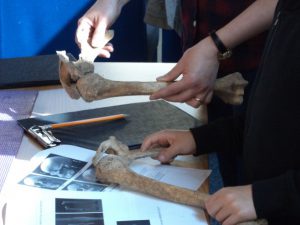
Comparing the ball and socket joints to discover the extent of his injury.
The importance of comparing bones was equally important when the youngsters looked for his other injury, although this time it was a matter of comparing joints as well as bones. As the YACs were keen to demonstrate, they could feel that the upper arm joined the shoulder blade at a ball and socket joint which gave them 360-degree movement. They then looked at the Roman man’s comparable bones and found that all was well on his left side but that this was definitely not the case on his right. There the socket had completely disappeared and the nice rounded head of the arm bone of the left side was distorted and roughened on the comparable right side. Consequently, again this would have meant bone rubbing on bone as he moved his arm, and, as Ellie said, probably this would have made a sort-of grinding noise when he tried to raise his arm, albeit this too, had healed in that it had changed between his accident and his death.
The animal bones also attracted a lot of attention, as did the CAT Kits, especially in the afternoon when we had a much larger group of youngsters, comprising members of the Bexley YACs and a similar number from North Kent YACs. Indeed, one youngster from the Canterbury YACs very carefully set out all the vertebra belonging to the sheep skeleton, while the dog skeleton was assembled and reassembled several times by various individuals. And turning to Ellie’s mystery object, a few got close while others came up with exceedingly creative suggestions, although nobody quite got that it was one of a pair of ice skates, Ellie showed an example from the Museum of London which had the necessary leather straps. This was the climax for both sessions, and it was clear from the chatter throughout that the YACs had found the experience enjoyable and had learned new things too, although so had Ellie and her team who were all very impressed with the youngsters’ level of knowledge and their obvious enthusiasm.
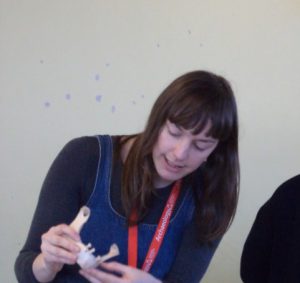
Ellie discusses what we can learn from the teeth.
Keeping with the ideas of enthusiasm and knowledge, yesterday I was at the Kent History Postgraduate seminar in the morning and went to hear Harriet Kersey’s paper on work from her doctoral thesis in the evening. In the morning, the first presentation was by Dean Irwin who is working on the middle tier of the medieval English Jewry, that is neither the very rich nor the very poor. Rather he is seeking to build up several biographies of Jews such as Cresse son of Genta who were living and trading in 13th-century England. By looking at their involvement in debt and other cases, Dean is keen to find out the networks within which men like Cresse operated, the commercial activities they engaged in, how they operated within the unit of the family, the roles undertaken by Jewish women, and the extent of their property interests. In terms of Cresse, the Kent links relate to the property he held in Canterbury, but he also had interests in Colchester and his primary residence was in London. Dean’s findings are very interesting and from a methodological perspective, it seems he will be able from these biographies to construct several models of Jewish men, especially their commercial activities, thereby getting away from the stereotype of the Jew solely as a money lender.
This sense of the importance of networks was also evident in Jacie Cole’s presentation using the sources she had found in the Canterbury Museum stores relating to the Second World War. What she didn’t find was letters or journals, but instead she found vast quantities of cuttings from local and regional newspapers from Canterbury and Kent. Although some of the articles may be useful for her study of food, she thinks many of the adverts will be valuable because they offer evidence of the necessity of trying to cure, or at least alleviate the symptoms of, a whole series of digestive ailments.
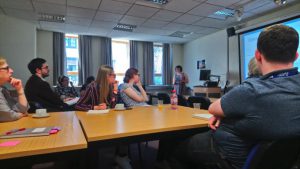
An attentive audience listens to Harriet’s paper.
Furthermore, there are also adverts relating to food preservation, and this crosses over into news items because of reported visits of celebrities to meetings of the WI, as well as calls for volunteers to pick fruit and other types of short harvest-season produce. Finally, Jacie also discussed the role of the British Restaurants, the use of regional menus, albeit they were produced centrally, and the relationship between a main restaurant and satellites in smaller settlements. These inter-connections between the national, regional and local sound interesting and may pay further investigation to see whether local and seasonal availability of particular foodstuffs had any bearing on the ideas of the central bureaucrats.
Now, turning to Harriet’s paper, a large audience of staff and students was treated to a fascinating discussion regarding the security, or not, of a noblewoman’s property rights in medieval England. Using a series of case studies, including the heiresses to the honour of Chester and the Ferrers branch of the Marshal family, Harriet first explored the situation whereby in the 13th-century the law gave multiple sisters as co-heiresses rights of inheritance when there were no direct and legitimate male heirs. Yet, as she said, this was not always straightforward because the law was at times flouted, often if not exclusively by the reigning monarch, which meant some women had to negotiate, a process that might take a considerable time, as well as expense, and involve proceedings in the royal courts.
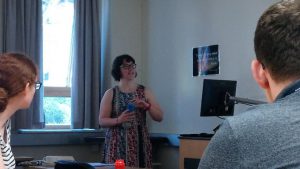
Harriet examines the importance of women’s property rights.
Harriet then went on to examine the other ways women could hold land, looking first at the marriage portion – a grant of land or rents which was transferred from the bride’s family to the bridegroom at marriage, and which would come to her in widowhood. Before going on to discuss matters of dower: the grant of a third of her husband’s lands that the woman received when widowed for the remainder of her life. One of the issues Harriet raised was the importance of Magna Carta regarding such provisions, but as with matters of inheritance the law was not always adhered to and some women had to fight, or at the very least negotiate, for what was rightfully theirs. Again, Harriet used a series of case studies to illustrate the issues involved, and some of these were picked up in the questions after her paper. This discussion demonstrated just how engaged the audience had been, a fitting end to the penultimate staff/student seminar of this academic year. And next week I shall be reporting on the Medieval Settlement Research Group’s conference at CCCU that Dr Andy Seaman is organising this coming weekend.
 Centre for Kent History and Heritage
Centre for Kent History and Heritage Sheila Sweetinburgh
Sheila Sweetinburgh 1107
1107